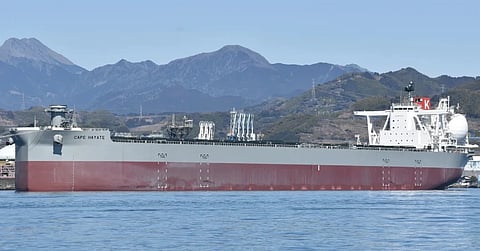

Kawasaki Kisen Kaisha (K Line) recently took delivery of a new Capesize bulk carrier fuelled by LNG. Cape Hayate was built by Japan Marine United (JMU) as the first Capesize bulk carrier in the K Line fleet to be equipped with a dual-fuel engine that can utilise both diesel and LNG, the latter serving as its primary fuel.
The vessel has an LOA of 299.99 metres (984.22 feet), a beam of 50 metres (160 feet), a draught of 18.44 metres (60.5 feet), a depth of 25 metres (82 feet), a deadweight tonnage of 210,870, a gross tonnage of 110,439, and a speed of 14 knots. Power is provided by a WinGD 7X62DF-2.1 13,900kW (18,600hp) engine with electronic controls. An intelligent control by exhaust gas recycling (ICER) system improves fuel efficiency and reduces methane slip when using LNG fuel.
An automated kite system utilising wind power will be installed at a later date to reduce operating emissions even further. The kite system will consist of a paraglider flying 300 metres (1,000 feet) above sea level to use wind power to propel the ship, reducing the load on the main engine and allowing fuel consumption to be reduced by 20 per cent on average during normal sailings. The system can be safely deployed, operated, and stowed with minimal input from the crew.
The use of LNG – which can reduce CO2, SOx and NOx emissions significantly – and the wind-assist kite system developed by Kawasaki will help K Line in achieving its 2030 goal of improving CO2 emissions efficiency by 50 per cent compared with 2008. The company said this figure surpasses the International Maritime Organisation's goal of 40 per cent.
A low-pressure main engine setup was selected partly to allow the installation of a simplified fuel gas supply system including generators and auxiliary boilers. This will then allow the machinery to take up less space and consume less power without any decrease in performance. Any boil-off gas in the LNG tank that would otherwise go to waste will instead undergo re-liquefaction for use by the generators and the auxiliary boilers, as these are also dual-fuel capable.
The ship also boasts some of JMU's proprietary energy-saving devices such as a bulbous bow, stabilising fins, and a rudder that can help achieve high fuel efficiency. The LNG fuel tank is located at the stern to ensure the same cargo hold volume and high fuel efficiency as vessels that operate on conventional fuel.
Cape Hayate was completed in compliance with ClassNK rules. The ship will be used to transport iron ore and coal from Australia to Japan on behalf of JFE Steel Corporation under a long-term consecutive voyage charter contract.
| Cape Hayate | |
| SPECIFICATIONS | |
| Type of vessel: | Bulk carrier |
| Classification: | ClassNK |
| Flag: | Japan |
| Owner: | Kawasaki Kisen Kaisha, Japan |
| Builder: | Japan Marine United |
| Length overall: | 299.99 metres (984.22 feet) |
| Beam: | 50 metres (160 feet) |
| Draught: | 18.44 metres (60.5 feet) |
| Depth: | 25 metres (82 feet) |
| Deadweight tonnage: | 210,870 |
| Gross tonnage: | 110,439 |
| Main engine: | WinGD 7X62DF-2.1, 13,900 kW (18,600 hp) |
| Maximum speed: | 14 knots |
| Other electronics: | Intelligent control by exhaust gas recycling system |
| Other equipment installed: | Stabilising fins |
| Types of fuel: | Diesel; LNG |
